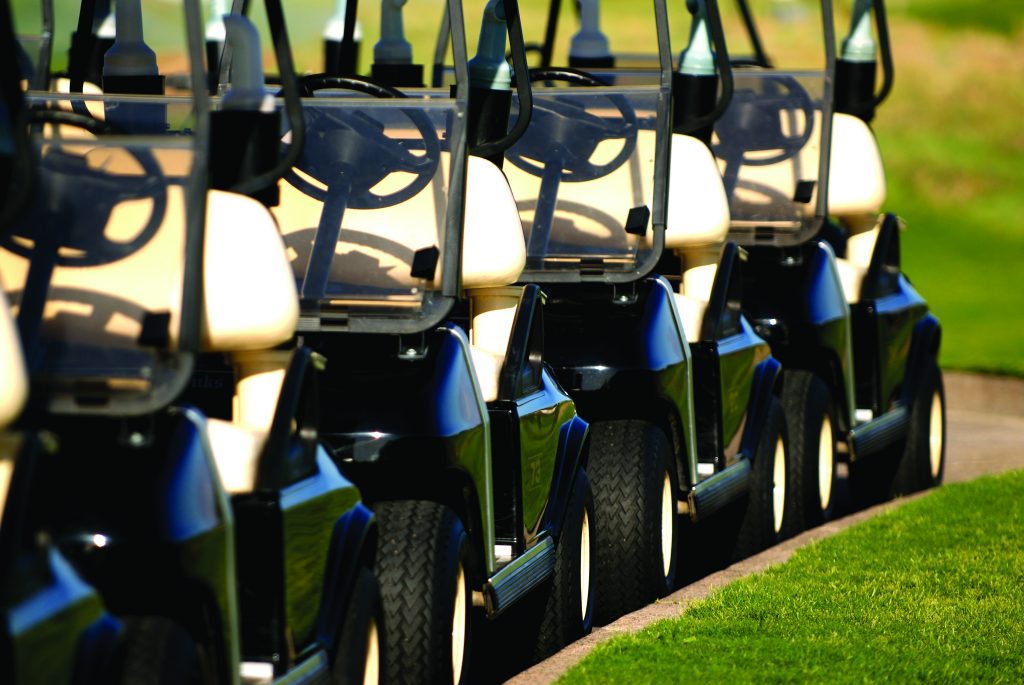‘Some traffic on the golf course is better than none’
Related Articles
Recent research has found that rolling, because it increases micro-pore space, suppresses dollar spot and fusarium patch incidence. And this means, explains Conor Nolan, that some traffic on the golf course – rather than none – makes for more difficult disease entry
Excessive traffic, that cannot be dispersed sufficiently, combined with poor environments, high rainfall and insufficient drainage, has inhibited the spread of the finer grasses.
We could argue that it’s the number one disturbance pressure that we encounter, although verticutting and grooming have been contributors too. Where we have relaxed or ceased the latter treatments, providing all other conditions of good drainage, air movement and so on were met, there has often been an upsurge in the population of the finer grasses, once play wasn’t excessive.
What is the right level of golf traffic?
This is a very difficult question to answer as it depends on many variables such as the local climate, concentration of traffic, distribution of traffic throughout the year, drainage, nitrogen inputs and the sward type that you have or wish to promote.
For example, on the east coast of Ireland I visit a golf course that has fescue-dominant greens with playing levels estimated at 50-60,000 annual rounds.
If that course was located on the wetter and more exposed west coast that same level of golf would only favour annual meadow-grass without doubt.
Certainly, if the sward is thin, has a brown hue or looks tired, despite following a recognised approach to fine grass promotion without much success, then traffic levels are too high for the pursuit of that sward type.

Turf ironing / rolling
Verticutting and grooming at this stage are recognised disturbance pressures but what about rolling and its impact on the finer grasses?
Over time and based on the visual impact on sward quality and grass species, I have increasingly looked upon rolling / ironing as equivalent to traffic in terms of leaf bruising. The observation has become more acute in recent years as rolling became a standard treatment and we began to see its effects.
Depending upon the intensity and type of roller / iron, rolling can have a detrimental impact on the finer grasses and their spread. Put one way the greater the output in terms of ball roll distance a roller delivers, the greater the potential suppression. Albeit, the damage noted also depended on the prevailing traffic levels and concentration of traffic.
Many courses that were struggling to see the finer grass spread ceased or cut back a lot on rolling to great effect. No such great impact was seen on those courses where both rainfall and traffic levels were on the high side.
However, there has been discussion of late on the use of lightweight rollers in the successful suppression of disease activity, as an alternative to fungicide control.
First off, research (Giordano et al, 2012) demonstrated that of the various frequencies and time of day possible, rolling twice per day during the main growing season brought the greatest reduction in dollar spot (Clarireedia jacksonii) disease incidence on Agrostis stolonifera ‘independence’.
More recent research suggested good control of fusarium patch (Microdochium nivale) on Poa annua, albeit not complete control, with the same twice daily and five times weekly rolling regime during the low season. However, there has been no note made on the negative impact on the grass species’ population during this research, which would need to be looked at given the high levels of rolling suggested.
Recent observations
I’ve also observed something that occurs at the other end of the traffic spectrum – insufficient foot traffic in relation to disease, notably fusarium patch.
I recently visited two Belgian courses at the end of the winter. One was in Wallonia which recently introduced a total pesticide ban on golf courses. The other, like in the UK and Ireland, no longer had access to iprodione, the standard ‘knock down’ fungicide active ingredient in recent times.
Both courses had been very successful in promoting Agrostis stolonifera / Agrostis capillaris in recent years, helped by their low levels of traffic and good-sized greens of multiple flag locations.
On my early spring visit to those courses I was shocked by the level of fusarium patch scarring on greens, particularly to the course without permission to apply any fungicide.
This was despite implementing nearly every conceivable cultural practice to discourage conditions for activity. Disease pressure had been very high during November and December with no frost of significance experienced.
Furthermore, nine greens were out of play for the previous ten months due to re-design of the surrounds. Those greens presented a more severe level of dollar spot scarring in September.
However, on that same course two out of the 20 greens were essentially disease-free despite similar construction types, grass species, maintenance inputs and environmental conditions.
The two greens were the practice putting greens where play was more concentrated, perhaps, dare I say it, to ‘normal’ levels. The main putting green on the other course presented much less fusarium patch on the recent visit also. Thankfully recovery was underway, which will be much faster than with Poa annua sward types.

Could it be that lack of traffic favoured higher levels of disease activity?
It would certainly tie-in with the suggestion by researchers that rolling suppressed dollar spot and fusarium patch incidence. The belief largely put forward to explain this is that rolling by squeezing increases the micro-pore space at the top of the profile which elevates moisture content and thus conditions favourable for a better- balanced microbial population.
Our belief, at this point, is that a certain level of traffic induces a plant biomechanical response resulting in a thickening of plant cell walls as a defensive mechanism, which makes for more difficult disease entry.
What to do?
Other than increasing play where deficient which is something that may not be possible, in the short term we will try to impose disturbance firstly through careful rolling year-round.
Rolling will only occur during the slower growing months when there is growth. That level of rolling will have to be closely monitored as excessive rolling would be damaging to the finer grasses and the aprons / collars. Any thinning, leaf tip die-back or visual tiredness would mean adjustment of the intensity / postponement.
Did I ever think in recent years that I would be advocating for more traffic or its equivalent? As in life we routinely hear that success is all about balance; achieving the right balance.
While the vast majority of golf courses have either an appropriate level of golf traffic or excessive traffic there are some that are on the other end of the spectrum and may not receive enough to impact some diseases, it would appear.
The lack of fungicides in places has given us a new possible insight into the influence of traffic, or lack of, on disease not considered to any great extent before due to the masking that fungicides gave in the past. We will see.
Conor Nolan is a senior agronomist with the STRI

























